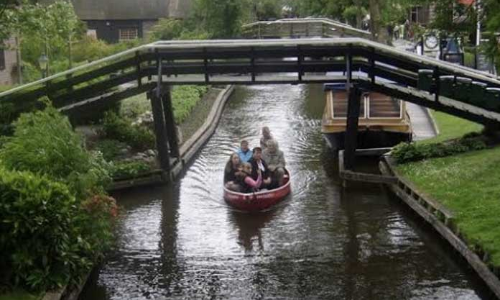Live
- Govt gets 7 bids under PLI for battery mfg units
- PSBs can’t issue lookout circulars
- 41 candidates file nominations in Nellore district
- K’taka, Gujarat top States in clean energy transition
- Lord Rama Brahmothsavalu concluded on grand note
- Meta Unveils Ray-Ban Smart Glasses Update for WhatsApp Video Calls
- Barrelakka files nomination as Nagarkurnool candidate
- BRS chief KCR to Embark on Bus Yatra Ahead of Parliamentary Elections from today
- Congress still undecided
- All-time highest score by Narayana student in AP SSC results
Just In

GIETHEOORN, in the Dutch province of Overijssel, The most amazing village is often called the veince of the Netherlands as the canals go through the entire village which is located in the municipality of steenwijkerland, with a population of 2,620
GIETHEOORN, in the Dutch province of Overijssel, The most amazing village is often called the veince of the Netherlands as the canals go through the entire village. which is located in the municipality of steenwijkerland, with a population of 2,620. But unlike the Italian City of water, here are no streets and no modern transportation, what we get to see here is all canals.

Anyone going to Giethoorn should leave their car outside the village and take the local means of transport available there and travel that is by boat. Usually by "whisper Boat", which has an electric, noiseless motor, because diesel engines are forbidden in this area. Renting a boat would be a great experience as they run slow, you can enjoy the place, take photos, and take it all in. The owners must be used to tourists staring at the beauty of their homes, so they act like there is nobody around.

House in this village are located in small, private islands, which are connected by bridges. Lots of bridges. To be precise, there are more than 180 bridges in Giethoorn.

Giethoorn is a very remote village which is very quite and too serene. The name given to it Venice of Netherlands gives a false imaage to the travellers of size and crowds, and commercialism within the village. The loudest sound you can normally hear is the quacking of the duck or the noise made by other birds.

Imagine life without cars... life here is all beautiful. Just imagine what life would be like there every day you'd arrive home by boat to your small, private island and enjoy the stunning view from your living room. Silence. Beauty. Peace. Well, the most of the time, when the village isn't swamped by tourists.

The best time to vist this place is in the month of mid-April and mid-october. you can choose almost any date from this time to visit Giethoorn but try to avoid August, when the village becomes too crammed with tourists. Try to stay for two to three nights to enjoy the tranquility and appreciate the beauty and serenity of the village.

The best place to stay: If you want to stay in hotel, you should try Hotel de Harmonie, which is situated along a canal in the northern ( more quiet part) of the village. Of course, the cheaper option anytime would be to rent a small farmhouse.

Best places to eat: There are a few restaurants nestled between the beautiful houses. De Rietstulp is the best place to eat.

Giethroom apart from Charming villages, we stopped by many tulip fields that blanket the area, bursting with color. There are many fields completely accessible to visitors and no one around.

Let's know some Interesting Facts:
The name Giethoorn means "Goat horn" and is derived from the first inhabitants discovery of hundrends of goat horns in the area. Unfortunately, today you can't find any horns here.
Usually in winter, the canals freeze over and are used for ice skating by locals and tourist alike.
Giethoorn is amazingly popular among Chinese visitors. About 200,000 tourists from China come to the village ever year. Considering the fact that total population of Giethoorn is just 2,620, this number looks very impressive.
Despite the number of tourists and the public attention it gained from the monoploy win, Giethoorn remains one of the most truly scenic and predominantly unspoilt destinations in Europe.
HISTORY OF GIETHOORN
About 1230 Giethoorn was founded by refugees who came from areas around the Mediterranean. These first inhabitants, Flagelanten, found horns of wild goats, who died during a flood. They called their settlement Geytenhoren. Is this name later corrupted into Geythorn, which later became Giethoorn.
The characteristic of the village has its orgins in the peat. The peat diggers took on the for their favourable locations the peat from the soil, mixed in a mixing bowl and threw it on the land to dry, then there was stabbed peat. Lakes were created. To transport the peat groove one trips an locks. Many houses are therefore on islands only, which still are to be reached only through the arched bridges and plank bridge.
READ 110(!) YEAR OLD ARTICLE
In the 'Kingdom of the Netherlands' oldest film of Netherlands from 1921 is a small minute attention to giethoorn with images of Princess Juliana in a punt.
Tourist here became really well known after the film fanfare (1958) by Bret Haanstra. Since 18 October 2008 is a statue of Albert Mol in the Centre opposite the Baptist Church. whereas, previously the income mainly came from the peat extraction are nowdays the main income of the tourism and the cane cultivation. The cane is a first quality and is used for roofing.

© 2024 Hyderabad Media House Limited/The Hans India. All rights reserved. Powered by hocalwire.com







